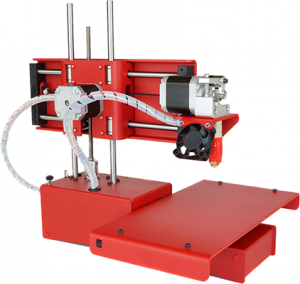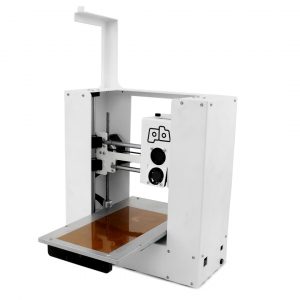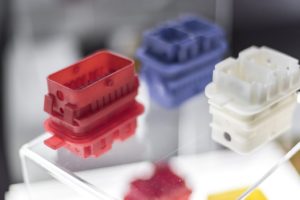 In a competitive market, it’s hard for any company to stay ahead of the others, and it’s a sad fact that even some of the most popular and long-lived companies succumb to heavy weather. Printrbot, founded in 2011, had legions of fans who loved its printers’ affordability, ease of assembly and use, and open source freedom. Printrbot 3D printers were 3D printers for the people – only a few hundred dollars, they provided access to 3D printing technology for people who hadn’t been able to afford it before, and although they were simple, they were high quality. Best of all, you could make them your own, tinkering with them and creating new and unique machines, as so many users did. The company was ethical, direct and honest. Some open source 3D printer companies just download files and don’t share. Printrbot dutifully shared its source files and was a rare true open source company.
In a competitive market, it’s hard for any company to stay ahead of the others, and it’s a sad fact that even some of the most popular and long-lived companies succumb to heavy weather. Printrbot, founded in 2011, had legions of fans who loved its printers’ affordability, ease of assembly and use, and open source freedom. Printrbot 3D printers were 3D printers for the people – only a few hundred dollars, they provided access to 3D printing technology for people who hadn’t been able to afford it before, and although they were simple, they were high quality. Best of all, you could make them your own, tinkering with them and creating new and unique machines, as so many users did. The company was ethical, direct and honest. Some open source 3D printer companies just download files and don’t share. Printrbot dutifully shared its source files and was a rare true open source company.
Printrbot has a large community of fans, so many are shocked and saddened today to learn that the company is closing its doors, citing low sales.
“Low sales led to hard decisions,” says the message that greets visitors to the Printrbot website. “We will be forever grateful to all the people we met and served over the years. Thank you all.”

Brook Drumm
The site also states that more information will be forthcoming in the future, but not right away – Founder Brook Drumm will be unavailable for comment for a while.
Mourning has already begun in the Printrbot community, with fans expressing their sadness via social media.
“Sad news for desktop 3D printing,” Tweeted Mike Grauer Jr. “Printrbot is no more. It has closed its doors. Loved that company. Good products.”
“I’m in shock, been following #Printrbot since 2011,” said user @Afro3dP. “Brook was definetly a one of a kind unique adventurer in the 3D printing world.”
“My first printer was a @printrbot, so this feels extra sad for me,” said Twitter user Andrew Sink. “Brook was a an excellent community leader, and I hope he lands on his feet. You guys will be missed!”

Printrbot Simple Metal
Printrbot 3D printers were many people’s first 3D printers, as at the time, they were about as inexpensive as a 3D printer could get. Since then, things have changed, and the market has been flooded with cheap 3D printers. Some of them are clearly “you get what you pay for,” but there’s also plenty of quality printers out there at affordable prices, meaning that Printrbot has gained a lot more competition since its early days. The company had plenty of loyal fans, but there were also plenty of others who were swayed by cheaper machines found on Kickstarter and elsewhere.
It’s not that Printrbot didn’t grow and change along with the market – it did very well, in fact, at adapting to changing consumer interests. In recent years, the company began shifting to a more prosumer angle, introducing a new version of the Simple Metal in 2016 with professional features – which was great for those looking for something more high-end but still on the affordable side. Its original customer base, however, may have been chagrined to see new 3D printer introductions with price tags raising to $1,000 or above.
Last year, Printrbot started getting even more experimental with a nod toward mass production, as it unveiled the Printrbelt concept: a conveyor belt-style 3D printer capable of printing continuously and creating items of any length. A fascinating concept, to be sure, but a long way from its simple hacker beginnings, perhaps making its original customer base feel a bit alienated.

Printrbot Play
While it’s sad for a company itself when it closes, it’s the loyal customers who suffer alongside it, and Printrbot’s many users and fans are left with a sense of loss. Printrbot meant many different things for many different people – for some, it was their first introduction to 3D printing or their first chance to build a 3D printer themselves and become intimate with the workings of a marvellous machine. For others, it was a gateway to hacking, a printer that could be made one’s very own. Many people did amazing things with Printrbot 3D printers, with some even modifying them to be potentially able to save lives.
3D printers like Printrbot’s are, by their very nature, community-builders, as users network online to share tips and advice and to showcase the unique things they create. Gatherings like Midwest RepRap Festival thrive on 3D printers like these, with makers from around the world coming together to demonstrate the amazing things that can be done with a simple, inexpensive machine. With the shutting down of Printrbot also comes the shutting down of its community, and that’s just as sad, if not sadder.
Drumm has proven himself to be a brilliant and creative mind in the 3D printing industry, and though some may have been disappointed to see Printrbot move away from its hacker roots in recent years, the company never stopped delivering quality; hopefully Drumm will remain in the 3D printing industry and take on new endeavors after a time. Printrbot and its fans have learned a cruel lesson that many other companies, established or just starting out, have learned – there are way too many 3D printers on the market, and as they become more and more affordable, staying competitive is a tough task, no matter how beloved the company.
How are you affected by the closing of Printrbot? Discuss this and other 3D printing topics at 3DPrintBoard.com or share your thoughts below.











